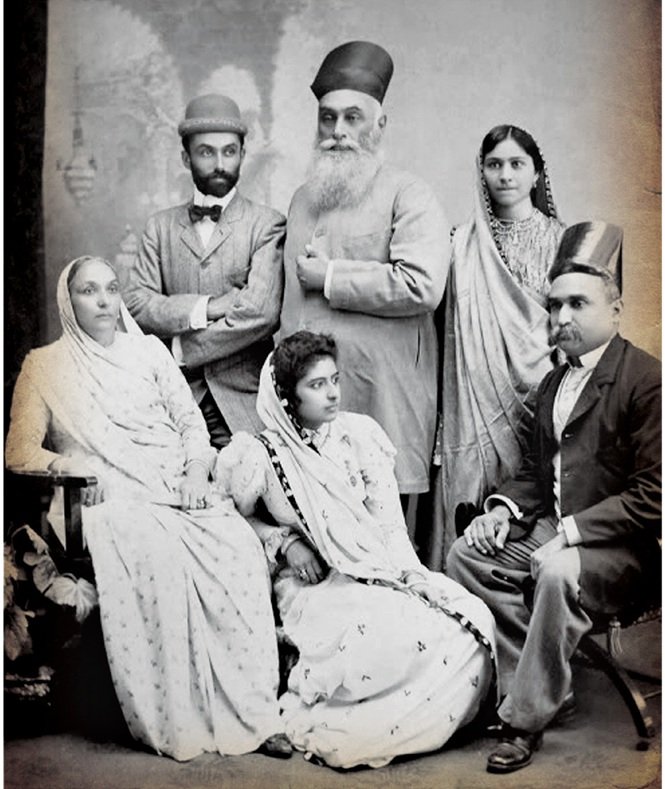The Tata Trusts owns two-thirds of the stockholding of Tata Sons Limited, the apex company of the Tata group of companies.
For over 130 years, Tata Trusts has remained dedicated to serving India with compassion and purpose.
In the vast tapestry of India’s social fabric, where over 1.4 billion souls navigate the complexities of progress and poverty, few entities shine as brightly as the Tata Trusts. As one of the nation’s largest philanthropic organizations, the Trusts embody a profound commitment to humanitarianism, serving as a prodigious force that propels social and economic development into uncharted territories. Far from mere charity, the Tata Trusts represent a visionary legacy—one that has sustained millions of lives for over 130 years, fostering hope, resilience, and self-reliance across the length and breadth of the country.
The Trusts’ story is not just one of wealth redistribution but of transformative empowerment. They symbolize the idea that true advancement lies in uplifting communities, not through fleeting aid, but through sustainable, systemic change. In a world grappling with inequality, climate challenges, and rapid urbanization, the Tata Trusts stand as a testament to what organized philanthropy can achieve when rooted in purpose and innovation. This article delves into the meaning and purpose of the Tata Trusts, traces their rich history, explores the allied trusts that form their backbone, and illuminates the key works that have etched an indelible mark on India’s developmental landscape.
***
The Meaning and Purpose
Pillars of Empowerment and Equity
At its core, the Tata Trusts are a constellation of charitable entities dedicated to fostering societal progress and economic inclusion. Comprising several interconnected foundations, they operate under a unified mission: to empower, enable, and transform communities, particularly the tribal, underserved, underprivileged, backward, and minority sections of society. With a special emphasis on women and children, the Trusts address multifaceted challenges through targeted interventions in health, nutrition, education, water and sanitation, livelihoods, social justice and inclusion, skilling, migration and urbanization, environment, digital literacy, sports, arts, crafts and culture, and disaster management.
The purpose of the Tata Trusts transcends traditional philanthropy. As articulated in their foundational ethos, they seek not to prop up the weakest momentarily but to elevate the gifted and capable, enabling them to serve the nation with greater efficacy. This philosophy, famously encapsulated by Jamsetji Tata—”What advances a nation or a community is not so much to prop up its weakest and most helpless members, but to lift up the best and the most gifted, so as to make them of the greatest service to the country”—remains the guiding light. By partnering with governments, international and local NGOs, and private welfare organizations, the Trusts create a collaborative ecosystem that maximizes impact. They provide grants, seed institutions, and implement direct programs, ensuring that aid evolves into enduring self-sustained growth.
In essence, the Tata Trusts mean more than financial support; they represent a covenant with India’s future—a promise to build resilient communities where every individual has the tools to thrive. Their work aligns seamlessly with the United Nations Sustainable Development Goals, from eradicating poverty and hunger to promoting gender equality and sustainable cities. By defining clear exit strategies once programs achieve scale, the Trusts ensure longevity, allowing their interventions to ripple outward independently.
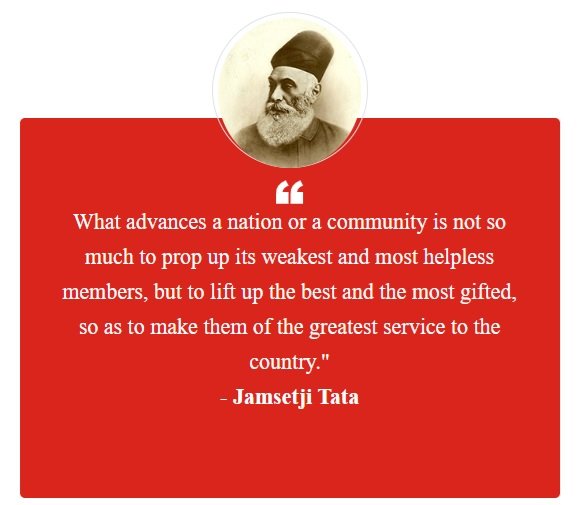
***
A Storied History
From Jamsetji’s Vision to a Century of Impact
The saga of the Tata Trusts begins in 1892, a pivotal year when Jamsetji Nusserwanji Tata, the founder of the Tata Group and revered as the ‘Father of Indian Industry,’ established the J.N. Tata Endowment for the Higher Education of Indians. This initiative was revolutionary, predating similar efforts in the West. While Andrew Carnegie’s endowment for what would become Carnegie Mellon University came in 1900, Jamsetji had already pledged half his personal wealth—Rs. 30 lakhs (equivalent to £200,000 at the time)—in 1898 toward a “university or institute of research” for his countrymen. This act redefined philanthropy, shifting it from sporadic alms-giving to strategic investment in human capital.
Jamsetji, a patriot and builder of modern India’s economy, wove welfare into the very DNA of his enterprises. He introduced groundbreaking employee benefits long before they became statutory norms: the apprentice system, crèches and primary classes for children of women mill workers, free medical aid, gratuitous pension funds, provident funds, maternity allowances, and accident compensation schemes. His innovations extended to urban planning, with the organized flat housing system and the iconic Taj Mahal Hotel in Mumbai, which blended luxury with social purpose.
Though Jamsetji’s grand dreams—a modern steel plant, a hydroelectric power facility, and a world-class scientific university—remained unfulfilled in his lifetime, they were realized by his sons, Sir Ratan Tata and Sir Dorabji Tata. These heirs not only expanded the Tata business empire exponentially but also institutionalized their father’s vision of “constructive philanthropy.” In 1919, Sir Ratan Tata Trust (SRTT) was founded, followed by Sir Dorabji Tata Trust (SDTT) in the same era. Over the decades, additional trusts emerged, consolidating under the Tata Trusts umbrella. Notably, these entities collectively hold two-thirds of the stock in Tata Sons, the holding company of the Tata Group, ensuring that corporate success fuels philanthropic endeavors.
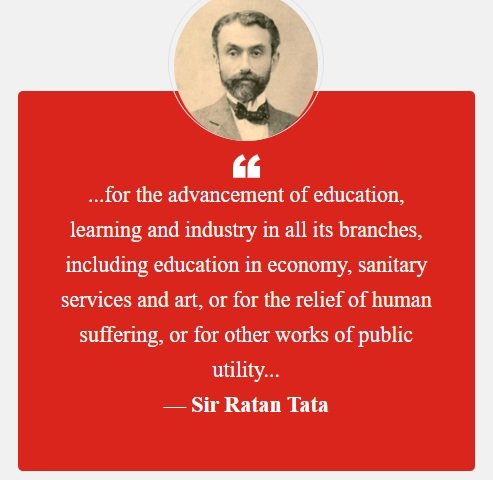
For over 130 years, the Trusts have adapted to India’s evolving needs—from pre-independence struggles to post-colonial reconstruction and contemporary crises like pandemics and climate change. Their history is a chronicle of resilience, mirroring the nation’s own journey. As Noel N. Tata reflects in the 2024-25 Annual Report, “Our legacy stretches back to pre-independent India, and, over the years, has witnessed the myriad challenges that confront the country and its people. It is the collective will for a better life, the resilience of the human spirit and the innate ability of communities to adapt, evolve and rise above adversity that has strengthened our resolve.”
This enduring legacy draws from India’s ancient philanthropic traditions, where the wealthy bore a moral duty to aid the less fortunate. Yet, Jamsetji elevated it to a modern paradigm, blending Parsi Zoroastrian values of charity with Enlightenment-era ideas of progress. Stories abound of untold acts of kindness: anonymous donations during famines, quiet support for freedom fighters, and visionary endowments that seeded India’s scientific renaissance. These narratives, preserved in archives and oral histories, paint the Tata Trusts not as distant benefactors but as intimate partners in the nation’s soul.
***
Business Significance
Owns two-thirds of the stock-holding of Tata Sons Limited
Tata Trusts is amongst India’s oldest, non-sectarian philanthropic organisations. The Trusts own two-third of the stock-holding of Tata Sons Limited, the apex company of the Tata group of companies. The wealth that accrues from this asset supports an assortment of causes, institutions and individuals in a wide variety of areas. This way, the profits that Tata companies earn, go back many times over to the communities they operate in. The funds have been deployed towards community development programmes across the country, for over 100 years now. The Tata Trusts continue to be guided by the principles of its founder, Jamsetji Tata. With his vision of proactive philanthropy and approach to ‘giving’, the Trusts catalyse societal development while ensuring that initiatives and interventions have a contemporary relevance to the nation.
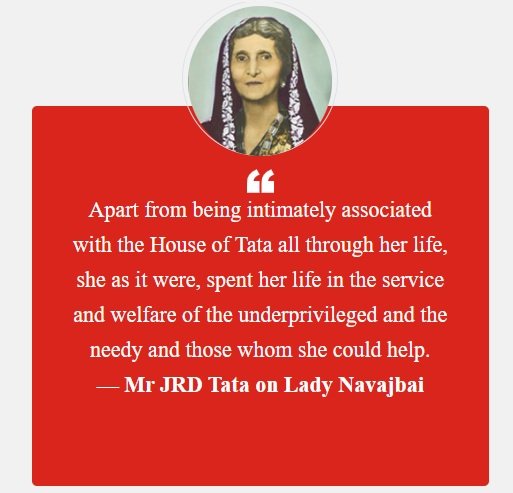
***
A Legacy of Philanthropy
The Tata Trusts Story
India’s long tradition of philanthropy is rooted in an ancient value system that emphasizes the moral duty of the privileged to uplift those who are less fortunate. This ethical principle — daan or selfless giving — has shaped Indian society for centuries. Yet, it was Jamsetji Nusserwanji Tata, the visionary founder of the Tata Group, who redefined this tradition for the modern age.
In 1892, Jamsetji established the J.N. Tata Endowment Fund to support the higher education of Indians. At a time when such acts of philanthropy were rare even in the West, this was a bold, transformative idea. Jamsetji believed that national progress depended on education and the development of human intellect, and he sought to empower Indians to study abroad and bring their knowledge home.
For perspective, industrialist Andrew Carnegie endowed US$1 million in 1900 to establish what would become Carnegie Mellon University — eight years after Jamsetji’s visionary act. In September 1898, Jamsetji went further, pledging half his personal wealth — Rs. 30 lakhs (then £200,000) — toward his dream of founding a “university or institute of research” in India. This vision culminated in the creation of the Indian Institute of Science (IISc) in Bengaluru, a cornerstone of India’s scientific advancement.
Over the past 130 years, the Tata family’s spirit of service has manifested in numerous institutions, trusts, and social initiatives. These range from pioneering universities and hospitals to cultural centers and scientific research institutions. Together, they have alleviated distress, advanced knowledge, and promoted the well-being of millions — not as acts of charity, but as investments in India’s future.
Today, these efforts are consolidated under the banner of Tata Trusts, a collective of foundations that continue to embody Jamsetji Tata’s ideal: “In a free enterprise, the community is not just another stakeholder in business, but is in fact the very purpose of its existence.”
This is not merely a story of giving — it is a story of nation-building through compassion, vision, and responsibility.
***
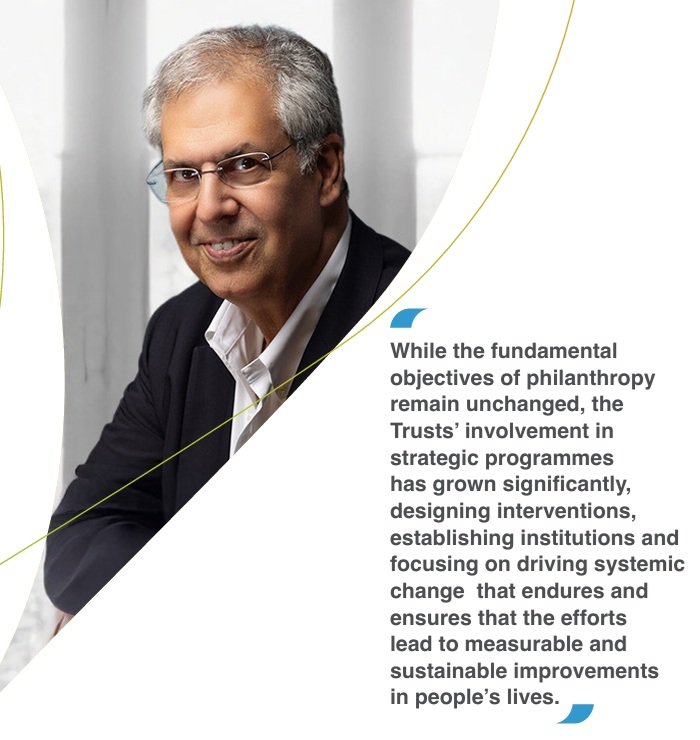
Allied Trusts
The Multifaceted Arms of Compassion
The Tata Trusts are not a monolith but a federation of allied entities, each with a distinct yet synergistic focus. This structure allows for specialized interventions while maintaining a cohesive strategy. Here’s a closer look at the key allied trusts:
- Sir Dorabji Tata Trust (SDTT): As one of the largest, SDTT channels resources into education, health, and rural development, embodying Sir Dorabji’s passion for sports and social welfare. It funds scholarships and medical research, ensuring access for the marginalized.
- Sir Ratan Tata Trust (SRTT): Established in 1919, SRTT is a pioneer in redefining charity. It supports innovative programs in social justice, arts, and culture, fostering creativity as a tool for inclusion. Its grants have revitalized traditional crafts and empowered artisan communities.
- Tata Education and Development Trust (TEDT): Launched in 2008, TEDT emphasizes multi-faceted social welfare with a national development lens. It promotes skilling and livelihoods, bridging the gap between rural talent and urban opportunities.
- Navajbai Ratan Tata Trust (NRTT): Founded in 1974 in memory of Sir Ratan’s wife, NRTT collaborates closely with SRTT on grant-making, focusing on women’s health and education to honor Navajbai’s legacy of quiet strength.
- Bai Hirabai Jamsetji Tata Navsari Charitable Institution (BHJTNCI): Dating back to 1923, this trust shares trustees with SRTT and aids Parsi and broader community welfare in Navsari, Gujarat, through education and healthcare initiatives.
- Sarvajanik Seva Trust (SST): Registered in 1975, SST provides targeted relief, reimbursing medical costs for individuals and offering scholarships for higher studies, embodying the Trusts’ commitment to personal empowerment.
- Jamsetji Tata Trust (JTT): A nod to the founder, JTT supports research and innovation, funding cutting-edge projects in science and technology.
- Tata Education Trust (TET): Dedicated to educational equity, TET seeds institutions and provides individual grants for deserving students.
- Tata Social Welfare Trust (TSWT): This arm tackles social inclusion, addressing migration and urbanization challenges.
- R.D. Tata Trust (RDTT): Focused on economic upliftment, it drives livelihood programs for rural and tribal populations.
- Lady Tata Memorial Trust (LTMT): A pioneer in medical philanthropy, LTMT funds cancer research and treatment globally.
- The J.N. Tata Endowment for the Higher Education of Indians (JNTE): The original 1892 endowment, it continues to sponsor advanced studies abroad and in India.
- The J.R.D. and Thelma J. Tata Trust (JRD&TJTT): Honoring J.R.D. Tata’s aviation and leadership legacy, it supports aerospace education and women’s empowerment.
- The J.R.D. Tata Trust (JRDTT): This trust advances fundamental research and ethical leadership in business and society.
Together, these allied trusts form a robust network, pooling resources to amplify impact. Their shared governance ensures alignment, while individual mandates allow for agile responses to localized needs.
Legacy of Philanthropy
The Evolution of Tata Trusts and Institutions (1892–2024)
| 1892 | J.N. Tata Endowment Fund | First major philanthropic initiative by Jamsetji Tata to support higher education for Indians in India and abroad. |
| 1911 | Indian Institute of Science (IISc), Bengaluru | Established through Jamsetji Tata’s vision and support; became India’s premier institute for scientific research. |
| 1912 | Sir Ratan Tata Department at London School of Economics | Funded by Sir Ratan Tata to promote social science research and policy education. |
| 1919 | Sir Ratan Tata Trust (SRTT) | Created to promote social and economic development in India; one of the oldest charitable trusts. |
| 1928 | Sir Ratan Tata Institute, Mumbai | Set up for scientific research and public health education, with focus on nutrition and home science. |
| 1932 | Lady Tata Memorial Trust (LTMT) | Established in memory of Lady Meherbai Tata; supports global research in leukemia and cancer. |
| 1932 | Sir Dorabji Tata Trust (SDTT) | Founded to promote health, education, and rural welfare; one of India’s largest philanthropic trusts. |
| 1932 | Lady Meherbai D. Tata Education Trust | Created to provide scholarships for Indian women pursuing higher education abroad. |
| 1936 | Tata Institute of Social Sciences (TISS), Mumbai | Established with Tata Trusts’ support; India’s first school of social work and community development. |
| 1941 | Tata Memorial Centre, Mumbai | Premier cancer treatment, research, and education institution funded by Tata Trusts. |
| 1944 | J.R.D. Tata Trust (JRDTT) | Focused on nation-building, science, and ethical leadership initiatives. |
| 1945 | Tata Institute of Fundamental Research (TIFR), Mumbai | Founded to advance India’s research in mathematics, physics, and computer science. |
| 1966 | National Centre for the Performing Arts (NCPA), Mumbai | India’s first multi-venue cultural institution promoting performing arts. |
| 1974 | Navajbai Ratan Tata Trust (NRTT) | Established in memory of Navajbai Tata to focus on women’s education and health. |
| 1974 | Jamsetji Tata Trust (JTT) | Supports science, technology, and innovation; continues Jamsetji Tata’s vision of national progress. |
| 1988 | National Institute of Advanced Studies (NIAS), Bengaluru | Promotes interdisciplinary research in science, philosophy, and social studies. |
| 1990 | Tata Education Trust, Tata Social Welfare Trust, and R.D. Tata Trust | Established to expand the reach of education, social welfare, and livelihood development. |
| 1991 | J.R.D. and Thelma J. Tata Trust (JRD&TJTT) | Promotes education, women’s empowerment, and leadership training. |
| 2008 | Tata Education and Development Trust (TEDT) | Focuses on scholarships, skilling, and rural development; funded Tata Hall at Harvard Business School. |
| 2008 | Tata Medical Center, Kolkata | Advanced cancer care and research hospital serving the eastern region of India. |
| 2013 | Tata Hall, Harvard Business School, USA | Funded by Tata Education and Development Trust; dedicated to executive education and global leadership. |
| 2017 | Tata Institute of Genetics and Society (TIGS), Bengaluru | Promotes advanced genetics research for health and agriculture. |
| 2024 | Small Animal Hospital, Mumbai | India’s first world-class animal healthcare and research facility supported by Tata Trusts. |
***
Key Works
Seeding Institutions, Transforming Lives
The Tata Trusts’ key works are legendary, having birthed some of India’s premier institutions and programs. In healthcare, they established the Tata Memorial Centre in Mumbai in 1941—India’s first dedicated cancer hospital—now a global beacon treating over 70,000 patients annually. The Lady Tata Memorial Trust has funded leukemia research worldwide since 1932, saving countless lives.
Education remains a cornerstone. The JNTE has sponsored over 5,000 scholars, many becoming leaders in science and policy. The Trusts seeded the Indian Institute of Science (IISc) in Bengaluru in 1909, a cradle of innovation; the Tata Institute of Fundamental Research (TIFR) in Mumbai, advancing particle physics; and the Tata Institute of Social Sciences (TISS), shaping social work curricula. Globally, they’ve endowed the Tata Centre for Technology and Design at IIT Bombay, MIT, the University of Chicago, and UC San Diego’s Tata Centre for Genetics and Society. Partnerships with Harvard’s South Asia Institute and the National Institute of Advanced Studies (NIAS) in Bengaluru further globalize Indian scholarship.
In rural and tribal development, the Trusts have empowered over a million through water conservation, sanitation drives, and nutrition programs. Initiatives like the Tata Affirmative Action Programme promote inclusion for Scheduled Castes and Tribes in employment. Disaster management efforts, from cyclone relief in Odisha to COVID-19 vaccine distribution, underscore their rapid response capabilities.
Sports and culture flourish too: SRTT’s support for the Indian Olympic Association has nurtured athletes, while crafts programs revive endangered artisanal traditions. Digital literacy drives in remote areas bridge the urban-rural divide, equipping youth with tech skills for the digital economy.
These works are not isolated; they’re integrated. For instance, the Tata Centre at MIT collaborates with Indian partners to deploy affordable tech for water purification, directly aiding rural health. Individual grants cover medical emergencies and education costs, touching lives one story at a time—a tribal girl’s engineering degree, a farmer’s irrigation system.
***
The Strategic Shift
From Grants to Governance
Recognizing the limitations of traditional grant-making amid escalating challenges, the Tata Trusts underwent a pivotal recalibration in 2015. Moving beyond passive funding, they embraced direct implementation, leveraging technology and forging deep partnerships. This shift entailed operational ownership: defining key outcomes, driving processes collaboratively, and measuring impact rigorously.
Today, the Trusts present a unified interface to beneficiaries, harnessing data analytics for precision targeting. Innovations like AI-driven crop advisory for farmers or blockchain for transparent aid distribution exemplify this tech infusion. Collaborations with state governments, such as nutrition missions in Maharashtra, amplify scale—reaching millions where solo efforts would falter.
This evolution reflects a maturing philanthropy: risk-taking for proof-of-concept at scale, with built-in sustainability. As programs mature, the Trusts exit gracefully, handing reins to empowered communities or governments, ensuring interventions endure.
***
Looking Forward
A Legacy Illuminating Generations
As the Tata Trusts stride into their second century, their gaze is fixed on the horizon. With new strategies across portfolios—from climate-resilient agriculture to AI ethics—they aim to impact millions sustainably. Each challenge is a call to innovate: urban migration demands skilling hubs; environmental degradation spurs conservation tech.
Noel N. Tata’s 2024-25 Annual Report message encapsulates this forward momentum: “No single institution… can address human challenges in isolation. Collaboration… is indeed a battle half-won.” He honors Ratan N. Tata’s vision of community-led development, urging stakeholders—partners, teams, communities—to co-create an equitable future. “Our biggest tribute to him and indeed, to our Founders, is to carry forward on the path they envisioned by positively impacting the lives of millions.”
In a nod to the founders’ untold stories, the Trusts preserve archives of Jamsetji’s famine relief, Ratan’s cultural endowments, and Dorabji’s sports patronage—reminders that legacy is lived through action.
***
Honoring a Timeless Covenant
The Tata Trusts are more than an institution; they are India’s philanthropic heartbeat, pulsing with the founders’ unyielding spirit. From Jamsetji’s 1892 endowment to today’s tech-infused interventions, their journey weaves meaning into purpose, history into hope. Allied trusts form the warp and weft, key works the vibrant threads, crafting a legacy that defies obsolescence.
In an era of fleeting trends, the Trusts remind us: true progress is patient, collaborative, and profoundly human. As Noel Tata, Chairman, Tata Trusts affirms, “This is what defines Tata Trusts—a legacy of purpose, compassion, and nation-building.” By upholding this inheritance, they not only honor the past but illuminate the path for generations, ensuring India’s oldest philanthropic legacy endures as its brightest promise.
Terms & Conditions: India CSR does not permit other Websites/agencies to copy or reproduce, or reprint the above article/feature in any form or means.


